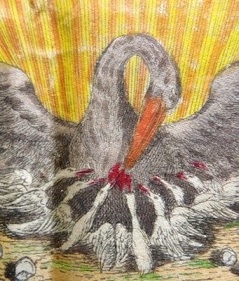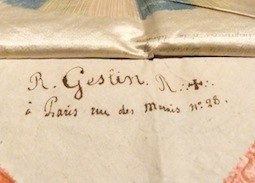french high degrees apron

Name
French Higher Degrees Apron (tablier aux quatre Ordres.)
Origin/date
France, c. 1830
In the French Rite there are 4 high degrees or Ordres: the Elu des Neufs, Ecossais, Chevalier d'Orient and the Sublime Prince Rose Croix. There are specific aprons for each degree but there are also aprons that combine the symbols of all, called tabliers aux quatre Ordres.
The apron was owned by René-Toussaint Geslin (name written in inkt under the flap. He became a Master Mason in 1837 and a Sublime Prince Rose Croix in in 1839. Both in a lodge and chapter named La Bonne Union in Paris. (I own both certificates, see last photo). Interesting detail: at that time Etienne-François Bazot, a known French masonic writer was both Worshipfull Master and Wise Master. He signed both documents.
Material and dimensions
Printed and painted on silk. Red silk border. 32 cm wide x 28,5 cm high.
Description
This apron features on the flap the symbol of the Pelican feeding his offspring. In the center is the open tomb of the resurrection with the shroud, the inscription INRI, the anchor of hope and the cross with a rose in its center. Other symbols refer to the degree of the Elu Secret with the secret cave, the source and the dog. The second degree or Scottish Grand Elect, the Cubic Stone and tipped the seven-branched candlestick. The third degree or Order of Knight of the East, with the eagle holding in its beak a banner demanding the release of captives Babylon, the broken chain of these captives and the Bridge, the Tower Temple and inflamed, the latter referring to the test of fire that was subjected to king Cyrus Zerubbabel to test him.
Provenance
France, private dealer
Literature
-
1.The museum of the Grande Loge Nationale Français
has a simular apron: http://www.glnf-musee.fr/matrice.asp? ARB_N_ID=22&COL_N_ID=543#
-
2.For other examples of tabliers aux quatre Ordres, see: Le Franc-Maçon en habit de Lumière, exhibition catalogue, Château de Tours, Association 5997, 2002, pp. 238-240 and Künzi, Frédéric, L’art dans la Franc-maçonnerie, Lausanne, Favre, 2011, p. 165
-
3.This specific apron is shown in: Franc-maçonnerie, objets de collection, Editions du Chêne, 2012, p. 41




